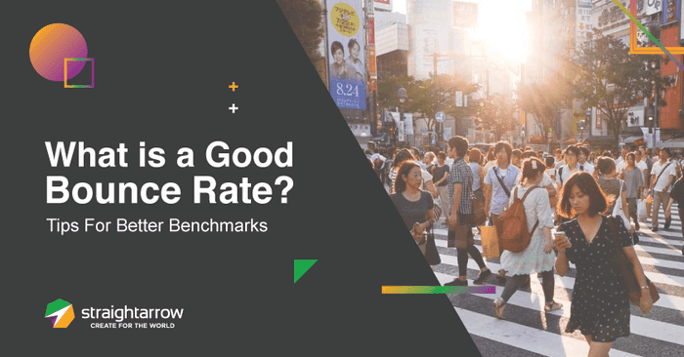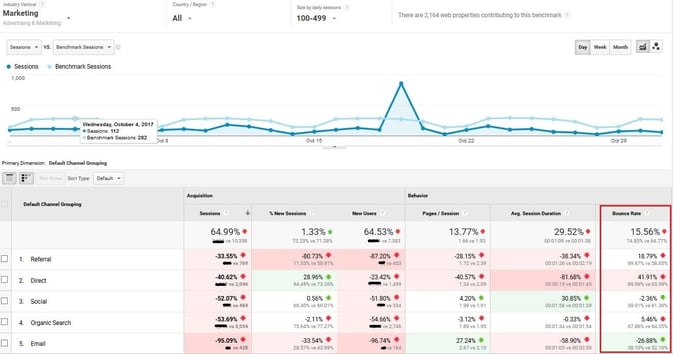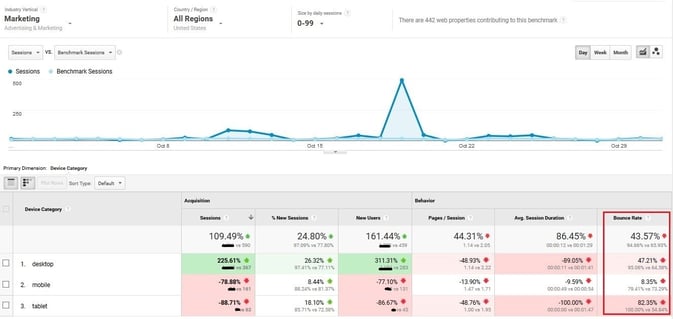
The basic rule of bounce rates is that lower is better. The question that has a lot of people stumped is “How low should it be for a page to be good?” Finding the right benchmark is all about knowing what your page is supposed to do.
That said, even a nuanced benchmark won’t always answer the question. Bounce rate is just one criterion in a page’s quality—and for some pages, it may not be cause for concern. Ultimately, determining a “good” bounce rate means knowing how your pages are used—and if that gets you the results you want.
Benchmarking Done Right
Many businesses use benchmarking as a way of keeping their pages’ bounce rates within an acceptable range. While it’s good to strive to meet or exceed industry standards, using the wrong benchmark data can backfire. It can cause needless frustration or, worse, force changes onto an already good page.
So how do you choose the right benchmark? Part of it is determined by industry, demographic, and other market factors—but the most important determinant is what your page is supposed to do.
It’s useful to return to what bounce rates are at this point. Putting it simply, a "bounce" just means that a page was accessed with no further interactions. This means that your bounce rate benchmark should reflect how much your page is supposed to encourage further interactions.
For example: a landing page with a high bounce rate would be cause for concern, as its entire purpose is to get people to go further. Meanwhile, a blog with a high bounce rate may not be as alarming, given that a blog’s purpose is to be read.
But this is where you have to turn to other data to fully interpret your bounce rate. Landing pages might have higher bounce rates if their forms require several answers, for instance. Meanwhile, a blog with a high bounce rate might still be good—but only if users are spending enough time on-page to read it.
The basic principle is that, beyond finding the right benchmark in terms of industry, demographic, and page type, you should also analyze bounce rate in light of other indicators and factors.
Common Factors Affecting Bounce Rate
Traffic Source
The expectations users bring with them when accessing your site have a lot of influence on how they’ll react to it. Outside of searches or direct traffic, users might come in with widely varying expectations.
Users who find your site through ads or social media posts may or may not be of the sort you’re looking for. This depends largely on how well the ads or social content is targeted. Poorly targeted content is less likely to attract your target audience, thus yielding more bounces.

Statistics by Channel
Page Type and Purpose
As mentioned earlier, bounce rate depends a lot on what the specific page is supposed to do. Not every page type is designed to make a user take further action within your website. Some pages direct users to take actions outside your site (e.g. send an email, call a number, visit a brick-and-mortar store, etc.).
Other times, you might design features that directly or indirectly heighten your bounce rate. Forms on landing pages are known to deter some users, for instance, but this is also used as a form of user self-sorting. It may or may not be bad depending on your intentions, but at the very least, it is by design.
Device Type
Device types play a part in user interactions. Bounce rates are generally higher on smaller devices. Users accessing pages on tablet bounce more than those on desktop; those accessing on phones bounce even more than those on tablets.
Keeping your pages mobile-friendly might mitigate this to a degree, but don’t expect it to fully even out.
That said, it’s also worth looking into which devices are most often used to access your pages and coming up with your tactics based on that.

Statistics by Device Used
Page or Site Problems
Of course, sometimes people are discouraged from interacting with your site by less deliberate design features. Slow websites, missing pages, and basic errors in page setup all increase the likelihood of bounces.
Sites that look old or poorly-designed in an aesthetic sense are also likely to repel users. If your site looks outdated, after all, users are liable to think it is so—not just in appearance, but in information and functions.
Features that Drive Users Away
Some features just straight-up repel users because of how they interfere with the experience. Pop-ups and ads are both likely to keep users from proceeding further. The more intrusive they are, the more users will turn away. Note also that some of these features can be used to artificially force interactions—this will decrease your bounce rate, but they won’t do you any favors in the long run.
Inflated Bounce Rates
Building on that, it’s also possible for your bounce rate to end up inflated by other means. Bots are fairly commonplace these days and, in many cases, aren’t malicious. But however well-meaning they are, they’re not users and their interactions won’t help you meet your targets.
You can avoid inflated bounce rates by adjusting your analytics and reporting setup. Furthermore, tracking traffic sources and other indicators will help you arrive at a more balanced interpretation of what your bounce rates really mean.
Looking for an expert opinion on your site’s performance? Send us a link to your site and we’ll give you an SEO assessment for free.













Comments